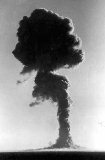 Totem/T1 - First view (10 K)
Totem/T1 - First view (10 K)



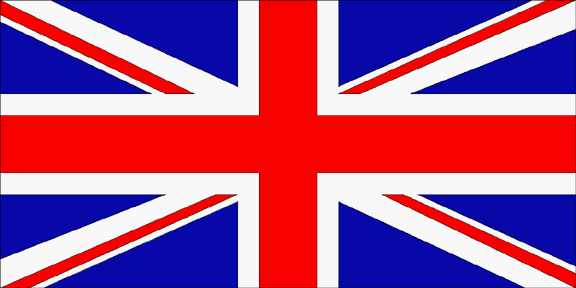



At the end of the countdown, there was a blinding electric blue light, of such an intensity I had not seen before or ever since. I pressed my hands hard to my eyes, then, realised my hands were covering my eyes. This terrific light power, or rays, were actually passing through the tarpaulin, through the towel, and through my head and body, for what seemed ten to twelve seconds, it may have been longer. After that, the pressure wave, which gave a feeling such as when one is deep underwater. This was then followed by a sort of vacuum suction wave, to give a feeling of one's whole body billowing out like a balloon. Observer, Mosaic G1 at Monte Bello, 16 May 1956. |
Last changed 23 August 2007
This series was intended to develop greater knowledge of fission weapons. The initial test (Hurricane) had been hurriedly carried out and was poorly instrumented. Although the bulk of the effort of the Hurrican task force had been to set up instrumentation, this had been for weapon effects measuremnt rather than weapon physics. Plutonium with a much higher Pu-240 content (and thus lower cost) was now being produced by the Calder Hall power reactors and needed to be evaluated in a nuclear test.
| Test: | Test 1 (T1) |
|---|---|
| Time: | 2130 14 October 1953 (GMT) 07:00 14 October 1953 (CST) |
| Location: | Emu Field, South Australia, 28:68 S 132.34 E |
| Test Height and Type: | Steel tower, 31 m |
| Yield: | 10 kt |
Second British test. The yield was greater than expected.
| Test: | Test 2 (T2) |
|---|---|
| Time: | 2130 26 October 1953 (GMT) 07:00 26 October 1953 (CST) |
| Location: | Emu Field, South Australia, 28:70 S 132.35 E |
| Test Height and Type: | Steel tower, 31 m |
| Yield: | 8 kt |
Third British test. The absolute maximum and minimum yield estimates were 10 and 0.25 kt respectively, with 2-3 kt most likely.
The U.S. had already demonstrated the feasibility of megaton size fission and thermonuclear bombs in October 1952, and by February 1954 the British had drafted requirements to add megaton weapons to their stockpile. The Teller-Ulam design had not been rediscovered by them at this point, and only pure fission designs were initially considered.
From March through May 1954 the UK was permitted by the U.S. to observe the Castle test series at Bikini atoll and use sampling aircraft in the mushroom clouds. This would have provided the British with clear, direct evidence of the high compression produced in the secondary stages by radiation implosion.
Possibly as a direct result of this data, on 16 June 1954 Winston Churchill decided that Britain should go ahead with H-bomb development, that is, to replicate the U.S. achievement (the USSR had not tested a staged thermonuclear bomb at this time).
Due to technical uncertainties a program of parallel development of alternate approaches was undertaken. The primary objectives were to acquire warheads with yields of approximately 1 megaton suitable for both an air dropped bomb, and a lighter one for the Blue Streak medium range ballistic missile (eventually canceled). Secondary objectives were to minimize the use of scarce and expensive fissile material in the designs. To achieve these ends a low-risk pure fission design, multiple boosted fission (Alarm Clock/Layer Cake like) designs, and staged thermonuclear designs were pursued. Since the pure fission bomb would have required 120 kg of U-235 (the entire annual production of Capenhurst, once expansion was complete in 3 years), and was too heavy for missile use, this was an option of last resort.
By mid-December 1955 the increasing international pressure for a halt to atmospheric testing gave further impetus to the parallel programs. It appeared quite possible that the UK might have only a very short window in which it could test megaton class weapons (and demonstrate this capability to the world). The requirement for a multi-megaton weapon had been added by this time, which only a two-stage thermonuclear device could provide. This decision was largely based on political considerations, since the Soviet Union had tested such a device on 22 November 1955.
By this time Britain had developed a pure fission design for the Mark 1 bomb case, and two boosted fission designs using U-235 surrounded by lithium deuteride: Green Bamboo and a smaller and lighter (but less efficient) device called Orange Herald. All were estimated to produce 1 megaton yields. They also had a large two-stage thermonuclear weapon design called Green Granite expected to produce multi-megaton yields (1-4 Mt). Green Bamboo and Green Granite were suitable for the heavy air-dropped bomb, only Orange Herald was suitable for the missile warhead. The Green Bamboo and Orange Herald devices were both quite expensive in fissile material. Green Bamboo required 87 kg of U-235, Orange Herald required 117 kg. Considering annual production was only 120 kg, neither of these devices could be deployed in very large numbers.
Fusion reactions using lithium deuteride fuel were ignited in the Mosaic test series conducted at the Monte Bello test site in the spring of 1956. Mosaic G1 (16 May 1956) produced a 15-20 kt yield and was apparently a failure. Mosaic G2 (19 June 1956), which produced an unexpectedly high 98 kt yield, provided data about fast fission of a U-238 tamper by fusion neutrons.
The primary purpose of this test series was to conduct research to support thermonuclear weapons development.
| Test: | G1 |
|---|---|
| Time: | 16 May 1956 (0350 GMT, 10:50 WAST) |
| Location: | Trimouille Island in the Monte Bello Islands, Australia, 20.23 S, 115.55 E |
| Test Height and Type: | Aluminum tower, 31 m |
| Yield: | 15 kt |
First British test using fusion fuel (as a physics experiment, not a weapon test). Fusion yield was negligible. Based on the results of this test it was decided that the G2 test could be safetly conducted using a natural uranium tamper instead of a lead tamper.
 Mosaic/G1 shot tower on Trimouille (503x379, 40 K)
Mosaic/G1 shot tower on Trimouille (503x379, 40 K)
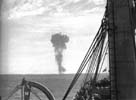 Mosaic/G1 as seen from the Narvik (42 K)
Mosaic/G1 as seen from the Narvik (42 K)
| Test: | G2 |
|---|---|
| Time: | 19 June 1956 (0214 GMT, 10:14 WAST) |
| Location: | Alpha Island in the Monte Bello Islands, Australia, 20.40 S 115.53 E |
| Test Height and Type: | Aluminum tower, 31 m |
| Yield: | 98 kt |
This was the highest yield test ever conducted in Australia. Since the test yield broke an assurance made personally by PM Anthony Eden of the UK to PM Robert Menzies of Australia that the yield would not exceed 2.5 time that of Hurricane (thus about 62 kt), the true yield was concealed until 1984. The option of
Mosaic G2 was a test of fusion-boosted weapon system, probably similar to the Soviet Sloika ("Layer Cake") and U.S. Alarm Clock designs. It incorporated lithium-6 deuteride, and had a uranium tamper (a version with a lead tamper was a standby option). The yield was more than 50% larger than expected.
This was the first test series at the Maralinga Test Range in South Australia (bordering Western Australia). It would reused in two other test series.
Buffalo combined atomic (fission) weapons development with weapons effects testing for military purposes.
| Test: | Round 1, One Tree Site |
|---|---|
| Time: | 27 September 1956 (0730 GMT, 17:00 CST) |
| Location: | One Tree Site, Maralinga Test Range |
| Test Height and Type: | Aluminum tower, 31 m |
| Yield: | 15 kt |
This was a test of the Red Beard tactical bomb, a plutonium implosion weapon (expected yield 16 kt).
| Test: | Round 2, Marcoo Site |
|---|---|
| Time: | 04 October 1956 (0700 GMT, 16:30 CST) |
| Location: | Marcoo Site, Maralinga Test Range |
| Test Height and Type: | Surface, 0.2 meters |
| Yield: | 1.5 kt |
This was a test of the Blue Danube bomb equipped with a low yield Mark I enriched uranium core (predicted yield just under 2 kt). The test was exploded on the surface rather than a tower to collect ground shock and cratering data. The bomb was placed in a shallow pit so the center of the nuclear reaction would be exactly at the surface. It produced a 160 ft wide crater and 40 ft deep, with a 58 inch lip.
| Test: | Round 3, Kite Site |
|---|---|
| Time: | 11 October 1956 (0557 GMT, 15:27 CST) |
| Location: | Kite Site, Maralinga Test Range |
| Test Height and Type: | Air drop, 150 m |
| Yield: | 3 kt |
This was Britain's first air drop test. It tested a Blue Danube bomb dropped from an RAF Valiant B1 bomber (WZ366 of squadron no. 49). This Service operational test was originally scheduled to use a service issue 40 kt core, but plans were changed due to concerns about contamination if the airburst fuze failed and a surface explosion resulted. A low yield bomb core was substituted .
| Test: | Round 4, Breakaway Site |
|---|---|
| Time: | 22 October 1956 (14:35:00:05 CST) |
| Location: | Breakaway Site, Maralinga Test Range |
| Test Height and Type: | Aluminum tower, 34 m |
| Yield: | "Rather less than 16 kt" (~10 kt?) |
This was another test of the Red Beard light weight tactical bomb with some fusion fuel included as a fusion physics experiment to supplement to Mosaic data.
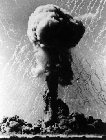 Breakaway - Second View (20 K)
Breakaway - Second View (20 K)
Operation Grapple was the British test program to develop a hydrogen bomb, and it continued intermittently over more than a year and a half, overlapping the non-thermonuclear Antler test series (see below). By January 1957 two variant designs had been developed for both Green Granite and Orange Herald. These were a light weight version of Green Granite (suitable for the missile), and a heavy weight version of Orange Herald using the Mark 1 case (too heavy for the missile, but more likely to be successful). Both Green Granite Large and Small (or Short) were expected at this time to produce a yield of about 1 Mt. A modified version of the Red Beard bomb (evidently to produce a higher yield) called Tom was used as the primary for both Green Granite designs.
The Green Granite Small, Orange Herald Small, and a device called Purple Granite which was substituted for Green Granite Large at the last minute (possibly a modified version of it) were ultimately tested in the 1957 Grapple test series at Malden Island in the Pacific. Green Granite Small was detonated in the Grapple 1/Short Granite test on 15 May 1957. Its yield was a disappointing 200-300 kt, but most of this was from the secondary stage providing proof of principle. Orange Herald Small was tested in Grapple 2/Orange Herald on 31 May 1957 producing 720 kt (the largest yield from this type of device on record). Surprisingly, Purple Granite produced an even smaller yield in the Grapple 3/Purple Granite test on 19 June 1957, about 150 kt.
All in all, this first phase was a mixed success. The rediscovered Teller-Ulam design, and a deployable megaton-class weapon design had both been proven. On the other hand, the H-bomb yields were far below those predicted. During the summer of 1957 the British government announced that it had successfully conducted thermonuclear tests. In his memoirs Prime Minister Harold MacMillan writes "On May 15 came the successful explosion of the first British H-bomb," referring to Grapple 1/Short Granite. This test was certainly an H-bomb, but not a very efficient one.
| Test: | Grapple 1/Short Granite |
|---|---|
| Time: | 15 May 1957 (19:37 GMT) |
| Location: | Off Malden Island |
| Test Height and Type: | Air drop, 2400 m |
| Yield: | 200-300 kt |
Dropped by a Valiant B1 bomber (XD818 of Squadron No. 49) piloted by Wing Commander K. Hubbard. Detonated after 52 sec of free fall.
This was Britain's first test of a radiation implosion thermonuclear bomb design. The device, named Green Granite Small, weighed 10,000 lb and used a modified Red Beard primary (called "Tom") and a lead-encased lithium deuteride secondary (called "Dick"). Most of the yield was from the secondary, providing evidence of successful radiation implosion, but the yield was far below the predicted value (about 1 megaton was expected).
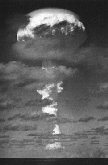 Grapple 1/Short Granite (60 K)
Grapple 1/Short Granite (60 K)
This was Britain's first truly successful thermonuclear bomb test in that the design yield was successfully reached. The test seems to have been hastily arranged. The bomber squadron was only notified about the test in September, followed by four weeks of intensive training in preparation. Documents indicate this test had not even been contemplated prior to the spring Grapple shots. The probable reason for this was that it was a rushed redesign following the disappointing Short Granite and Purple Granite shots, spurred on by British fears of an imminent test ban. Only one device, designated Round C, was tested with a yield of 1.8 Mt. This was Britian's first megaton-class explosion, showing that the UK had achieved mastery of H-bomb design.
| Test: | Grapple X/Round C |
|---|---|
| Time: | 8 November 1957 (17:47 GMT) |
| Location: | Off Christmas Island |
| Test Height and Type: | Air drop, 2250 m |
| Yield: | 1.8 Megatons |
Dropped by a Valiant bomber (XD824) piloted by Squadron Leader Barney Millett. Detonated after 52 sec of free fall.
Further development work on high yield thermonuclear weapons continued in 1958, with an international test moratorium rapidly approaching. Several high yield tests were conducted:
| Test: | Grapple Y |
|---|---|
| Time: | 8 April 1958 (19:05 GMT) |
| Location: | Off Christmas Island |
| Test Height and Type: | Air drop, 2350 m |
| Yield: | 2 Megatons |
Dropped by a Valiant bomber (XD825) piloted by Squadron Leader Bob Bates. Detonated 53 seconds after release, only 245 yards off target. This was Britain's fourth test of a radiation implosion thermonuclear bomb, and the second successful high yield test.
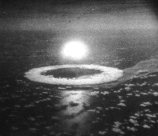 Grapple Y at Detonation
Grapple Y at Detonation
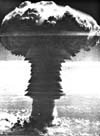 Grapple Y Cloud (369x500, 26 K)
Grapple Y Cloud (369x500, 26 K)
| Test: | Grapple Z/Pennant 2 |
|---|---|
| Time: | 22 August 1958 (17:24 GMT) |
| Location: | Christmas Island |
| Test Height and Type: | Balloon-burst over land |
| Yield: | ~1 Megatons |
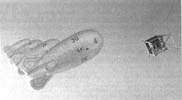 Grapple Z/Pennant 2 suspended from balloon (500x275, 22 K)
Grapple Z/Pennant 2 suspended from balloon (500x275, 22 K)
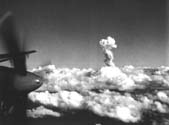 Grapple Z/Pennant 2 mushroom cloud (500x275, 22 K)
Grapple Z/Pennant 2 mushroom cloud (500x275, 22 K)
| Test: | Grapple Z/Flagpole 1 |
|---|---|
| Time: | 2 September 1958 (17:24 GMT) |
| Location: | Off Christmas Island |
| Test Height and Type: | Air drop, 2850 m |
| Yield: | 2.5-3 Megatons |
Dropped by a Valiant bomber (XD822) piloted by Bill Bailey from 45,000 ft, missed target point by a mere 95 yards. The first British use of blind radar bombing with a nuclear device. This was Britain's fifth test of a radiation implosion thermonuclear bomb. It was the first of Britain's two highest yield tests.
| Test: | Grapple Z/Halliard 1 |
|---|---|
| Time: | 11 September 1958 (17:49 GMT) |
| Location: | Off Christmas Island |
| Test Height and Type: | Air drop, 2650 m |
| Yield: | 2.5-3 Megatons |
Dropped by a Valiant bomber (XD827) piloted by Flight Lieutenant Tiff O'Connor. This was the second of Britain's two highest yield tests.
| Test: | Grapple Z/Burgee 2 |
|---|---|
| Time: | 23 September 1958 (17:49 GMT) |
| Location: | Off Christmas Island |
| Test Height and Type: | Balloon-burst over land |
| Yield: | 1 kt |
| Test: | Round 1 |
|---|---|
| Time: | 0505 (GMT), 14:35 (local time); 14 Sept 1957 |
| Location: | Maralinga (Tadje) |
| Test Height and Type: | 31 m aluminum tower |
| Yield: | 1 kt |
Test of Pixie, a lightweight small diameter implosion system with a plutonium core. This test later became notorious because of the experimental use of cobalt metal pellets as a test diagnostic for measuring yield (presumably by estimating the neutron flux from the degree of activation of the target pellet). Discovery of (mildly) radioactive cobalt pellets around the test site later gave rise to rumors that the British had been developing a "cobalt bomb" radiological weapon.
| Test: | Round 2 |
|---|---|
| Time: | 0300 (GMT), 10:00 (local time); 25 Sept 1957 |
| Location: | Maralinga (Biak) |
| Test Height and Type: | 31 m aluminum tower |
| Yield: | 6 kt |
Lightweight plutonium implosion device named Indigo Hammer, intended for air defense missile (Bloodhound) and thermonuclear primary applications.
| Test: | Round 3 |
|---|---|
| Time: | 0645 (GMT), 16:15 (local time); 9 Oct 1957 |
| Location: | Maralinga (Taranaki) |
| Test Height and Type: | 300 m balloon-burst over land |
| Yield: | 25 kt |
Test of a primary for a megaton range thermonuclear device. Used plutonium surrounded by highly enriched uranium. Expected yield range was 25-30 kt (maximum was 50 kt).
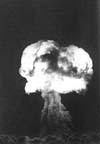 Antler Round 3, Maralinga (Taranaki) (29 K)
Antler Round 3, Maralinga (Taranaki) (29 K)
An important change was taking place in the UK's relationship with the U.S. which would profoundly change the nature of Britain nuclear weapons program. Previously nuclear cooperation between the two nations had been fitful. During the war cooperation had been very close. A team of British scientists had been deeply involved in weapons design at Los Alamos (the "British Mission"), and the close cooperation had been officially ratified by the Quebec Agreement (1943) and the Hyde Park Memoranda (1944). In 1946 though, the highly restrictive Atomic Energy Act (McMahon Act) had shut down exchanges of information (this had been an important motivating factor in initiating the British nuclear weapons program in the first place).
An amendment of the Atomic Energy Act in 1954 had made limited exchanges possible, and the pressures of the Cold War made the need for cooperation ever more urgent as time passed. Finally in 1958 a major revision to the Act was made (signed into law 2 July) that opened the gates for detailed collaboration. The first meeting under this revised law occurred 25-27 August 1958 in Washington. This brought about considerable understanding of each party in the status of weapons developments by the other side. In the second meeting (15-17 September 1958) at Los Alamos detailed designs of American weapons were passed to the British, including the Mk-28, 44, 45, 47, and 48 warheads and information on the TX-41 and 46 then under development. These were the most sophisticated weapon then available to the U.S.
With this flood of data, backed by numerous tests, and representing weapons that had been engineered to a high state of sophistication and had been manufactured in large numbers, the British abandoned the idea of developing and fielding their own designs. The versatile and compact Mk-28 was quickly adopted as the design for the next British weapon and by November an American team was at Aldermaston discussing Mk-28 weapon manufacturing requirements. The goal was for the first British production unit to be completed by April 1960.
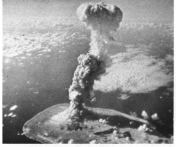
Test over Christmas Island.
Map of Christmas Island (58 K, 503 x 481)
After the 1957-1958 test series the United Kingdom ceased conducting its own independent nuclear tests. The reason for this was that it was no longer necessary. After the UK had demonstrated that it could develop thermonuclear weapons, the US adopted it as a strategic partner in deterring the Soviet Union. All subsequent UK nuclear weapons are based on US designs, which were made available to Britain. Once nuclear testing resumed in 1961, the US and UK also began conducting joint tests at hte NTS (Nevada test Site) in Nevada, eventually conducting a total of 28 (counting four zero-yield plutonium dispersal safety experiments). The first was the Pampas shot during Operation Nougat, 1 March 1962 (yield 9.5 kt). See summary table below for complete listing of these tests. At least two new British warheads (informed of course by U.S. weapon technology) were developed and test in the 1970s and 1980s, the Chevaline warhead, and the Trident warhead.
After the Grapple tests, the British lent Christmas island to the US in 1962 for the Dominic series of 25 tests.
| Test Series | Test Name | Location | Date | Yield | Explosion Conditions | Comments |
|---|---|---|---|---|---|---|
| Hurricane | Monte Bello (off Trimouille Is) | 3 Oct 1952 | 25 kt | Ocean surface burst (HMS Plym) | Levitated core plutonium implosion device | |
| Totem | Test 1 | Emu Field | 15 Oct 1953 | 10 kt | Tower | |
| Totem | Test 2 | Emu Field | 27 Oct 1953 | 8 kt | Tower | |
| Mosaic | G1 | Monte Bello (off Trimouille Is) | 16 May 1956 | 15 kt | Tower | |
| Mosaic | G2 | Monte Bello (off Alpha Is) | 19 June 1956 | 60 kt | Tower | |
| Buffalo | One Tree, Round 1 | Maralinga (One Tree) | 27 Sept 1956 | 15 kt | Tower | |
| Buffalo | Marcoo, Round 2 | Maralinga (Marcoo) | 4 Oct 1956 | 1.5 kt | Ground | |
| Buffalo | Kite, Round 3 | Maralinga (Kite) | 11 Oct 1956 | 3 kt | Airburst over land | |
| Buffalo | Breakaway, Round 4 | Maralinga (Breakaway) | 22 Oct 1956 | 10 kt | Tower | |
| Grapple | Grapple 1/Short Granite | Malden Is, Pacific | 15 May 1957 | 200-300 kt | Airburst over ocean | Radiation implosion thermonuclear device; 1 Mt predicted, some thermonuclear yield achieved |
| Grapple | Grapple 2/Orange Herald | Malden Is, Pacific | 31 May 1957 | 720 kt | Airburst over ocean | Fall back thermonuclear device, Alarm Clock/Sloika design using U-235 core |
| Grapple | Grapple 3/Purple Granite | Malden Is, Pacific | 19 Jun 1957 | 150 kt | Airburst over ocean | Second radiation implosion thermonuclear device, 1 Mt predicted |
| Antler | Round 1 | Maralinga (Tadje) | 14 Sept 1957 | 1 kt | Tower | |
| Antler | Round 2 | Maralinga (Biak) | 25 Sept 1957 | 6 kt | Tower | Lightweight plutonium implosion device named Indigo Hammer, intended for air defense missile (Bloodhound) and thermonuclear primary applications |
| Antler | Round 3 | Maralinga (Taranaki) | 9 Oct 1957 | 25 kt | Balloon-burst over land | Test of a primary for a megaton range thermonuclear device. Used plutonium surrounded by highly enriched uranium. Maximum design yield was 30 kt. |
| Grapple X | Round C | Christmas Is | 8 Nov 1957 | 1.8 Mt | Airburst over ocean | |
| Grapple Y | Grapple Y | Christmas Is | 28 Apr 1958 | 2 Mt | Airburst over ocean | |
| Grapple Z | Pennant 2 | Christmas Is | 22 Aug 1958 | ~1 Mt | Balloon-burst over land | |
| Grapple Z | Flag Pole 1 | Christmas Is | 2 Sept 1958 | 2.5-3 Mt | Airburst over ocean | |
| Grapple Z | Halliard 1 | Christmas Is | 11 Sept 1958 | 2.5-3 Mt | Airburst over ocean | |
| Grapple Z | Burgee 2 | Christmas Is | 23 Sept 1958 | 1 kt | Balloon-burst over land |
Legend:NAFR= Nellis Air Force Range (Nevada); NTS= Nevada Test Site
| Test Series | Test Name | Date (GCT) | Location | Test Type | Yield (kt) | Purpose | Comments |
|---|---|---|---|---|---|---|---|
| Nougat | Pampas | 1-Mar-62 | NTS | Shaft | 9.5 kt | Accidental release of radioactivity detected off-site | |
| Roller Coaster | Double Tracks | 15-May-62 | NAFR | Surface | 0 | Storage-transportation safety experiment, measured plutonium dispersal risk | |
| Roller Coaster | Clean Slate I | 25-May-62 | NAFR | Surface | 0 | Storage-transportation safety experiment, measured plutonium dispersal risk | |
| Roller Coaster | Clean Slate II | 31-May-62 | NAFR | Surface | 0 | Storage-transportation safety experiment, measured plutonium dispersal risk | |
| Roller Coaster | Clean Slate III | 9-Jun-62 | NAFR | Surface | 0 | Storage-transportation safety experiment, measured plutonium dispersal risk | |
| Storax | Tendrac | 7-Dec-62 | NTS | Shaft | <20 kt | ||
| Whetstone | Cormorant | 17-Jul-64 | NTS | Shaft | <20 kt | Accidental release of radioactivity detected on-site only | |
| Whetstone | Courser | 25-Sep-64 | NTS | Shaft | 0 | ||
| Flintlock | Charcoal | 10-Sep-65 | NTS | Shaft | 20 - 200 kt | ||
| Arbor | Fallon | 23-May-74 | NTS | Shaft | 20 - 200 kt | First test of the Chevaline warhead (TK-100?). | |
| Anvil | Banon | 26-Aug-76 | NTS | Shaft | 20 - 150 kt | Chevaline? | |
| Cresset | Fondutta | 11-Apr-78 | NTS | Shaft | 20 - 150 kt | Chevaline? | |
| Quicksilver | Quargel | 18-Nov-78 | NTS | Shaft | 20 - 150 kt | Chevaline? | |
| Quicksilver | Nessel | 29-Aug-79 | NTS | Shaft | 20 - 150 kt | Chevaline? | |
| Tinderbox | Colwick | 26-Apr-80 | NTS | Shaft | 20 - 150 kt | Chevaline? | |
| Guardian | Dutchess | 24-Oct-80 | NTS | Shaft | <20 kt | ||
| Guardian | Serpa | 17-Dec-80 | NTS | Shaft | 20 - 150 kt | Chevaline? | |
| Praetorian | Rousanne | 12-Nov-81 | NTS | Shaft | 20 - 150 kt | Chevaline? | |
| Praetorian | Gibne | 25-Apr-82 | NTS | Shaft | 20 - 150 kt | Chevaline? | |
| Phalanx | Armada | 22-Apr-83 | NTS | Shaft | <20 kt | Trident primary test? | |
| Fusileer | Mundo | 1-May-84 | NTS | Shaft | 20 - 150 kt | Trident? | |
| Grenadier | Egmont | 9-Dec-84 | NTS | Shaft | 20 - 150 kt | Trident? | |
| Charioteer | Kinibito | 5-Dec-85 | NTS | Shaft | 20 - 150 kt | Trident? | |
| Charioteer | Darwin | 25-Jun-86 | NTS | Shaft | 20 - 150 kt | Trident? | |
| Musketeer | Midland | 16-Jul-87 | NTS | Shaft | 20 - 150 kt | Trident? | |
| Aqueduct | Barnwell | 18-Dec-89 | NTS | Shaft | 20 - 150 kt | Likely Trident full yield test, seismic magnitude Mb 5.7 | |
| Sculpin | Houston | 14-Nov-90 | NTS | Shaft | 20 - 150 kt | Likely Trident full yield test, seismic magnitude Mb 5.7 | |
| Julin | Bristol | 26-Nov-91 | NTS | Shaft | <20 kt | Trident low yield option test? |





